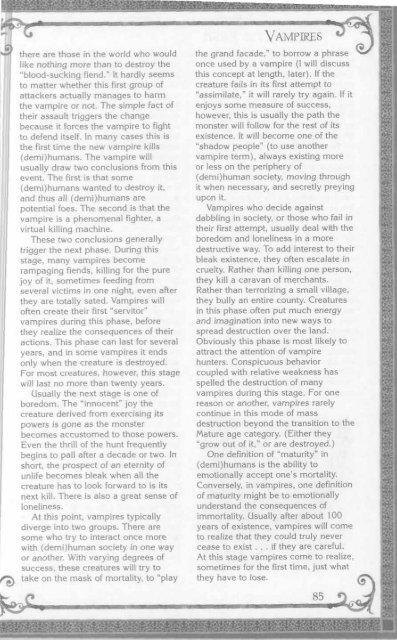Van Richten's Monster Hunter's.pdf - Askadesign.com
Van Richten's Monster Hunter's.pdf - Askadesign.com
Van Richten's Monster Hunter's.pdf - Askadesign.com
Create successful ePaper yourself
Turn your PDF publications into a flip-book with our unique Google optimized e-Paper software.
..’<br />
P?<br />
. there are those in the world who would<br />
like nothing more than to destroy the<br />
“blood-sucking fiend.” It hardly seems<br />
to matter whether this first group of<br />
attackers actually manages to harm<br />
the vampire or not. The simple fact of<br />
their assault triggers the change<br />
because it forces the vampire to fight<br />
to defend itself. In many cases this is<br />
the first time the new vampire kills<br />
(demi)humans. The vampire will<br />
usually draw two conclusions from this<br />
event. The first is that some<br />
(demi)humans wanted to destroy it,<br />
and thus all (demi)humans are<br />
potential foes. The second is that the<br />
vampire is a phenomenal fighter, a<br />
virtual killing machine.<br />
These two conclusions generally<br />
trigger the next phase. During this<br />
stage, many vampires be<strong>com</strong>e<br />
rampaging fiends, killing for the pure<br />
joy of it, sometimes feeding from<br />
several victims in one night, even after<br />
they are totally sated. Vampires will<br />
often create their first “servitor”<br />
vampires during this phase, before<br />
they realize the consequences of their<br />
actions. This phase can last for several<br />
years, and in some vampires it ends<br />
only when the creature is destroyed.<br />
For most creatures, however, this stage<br />
will last no more than twenty years.<br />
Usually the next stage is one of<br />
boredom. The “innocent” joy the<br />
creature derived from exercising its<br />
powers is gone as the monster<br />
be<strong>com</strong>es accustomed to those powers.<br />
Even the thrill of the hunt frequently<br />
begins to pall after a decade or two. In<br />
short, the prospect of an eternity of<br />
unlife be<strong>com</strong>es bleak when all the<br />
creature has to look forward to is its<br />
next kill. There is also a great sense of<br />
loneliness.<br />
At this point, vampires typically<br />
diverge into two groups. There are<br />
some who try to interact once more<br />
with (demi)human society in one way<br />
or another. With varying degrees of<br />
success, these creatures will try to<br />
take on the mask of mortality, to “play<br />
the grand facade,” to borrow a phrase<br />
once used by a vampire (I will discuss<br />
this concept at length, later). If the<br />
creature fails in its first attempt to<br />
“assimilate,” it will rarely try again. If it<br />
enjoys some measure of success,<br />
however, this is usually the path the<br />
monster will follow for the rest of its<br />
existence. It will be<strong>com</strong>e one of the<br />
“shadow people” (to use another<br />
vampire term), always existing more<br />
or less on the periphery of<br />
(demi)human society, moving through<br />
it when necessary, and secretly preying<br />
upon it.<br />
Vampires who decide against<br />
dabbling in society, or those who fail in<br />
their first attempt, usually deal with the<br />
boredom and loneliness in a more<br />
destructive way. To add interest to their<br />
bleak existence, they often escalate in<br />
cruelty. Rather than killing one person,<br />
they kill a caravan of merchants.<br />
Rather than terrorizing a small village,<br />
they bully an entire county. Creatures<br />
in this phase often put much energy<br />
and imagination into new ways to<br />
spread destruction over the land.<br />
Obviously this phase is most likely to<br />
attract the attention of vampire<br />
hunters. Conspicuous behavior<br />
coupled with relative weakness has<br />
spelled the destruction of many<br />
vampires during this stage. For one<br />
reason or another, vampires rarely<br />
continue in this mode of mass<br />
destruction beyond the transition to the<br />
Mature age category. (Either they<br />
“grow out of it,” or are destroyed.)<br />
One definition of “maturity” in<br />
(demi)humans is the ability to<br />
emotionally accept one’s mortality.<br />
Conversely, in vampires, one definition<br />
of maturity might be to emotionally<br />
understand the consequences of<br />
immortality. Usually after about 100<br />
years of existence, vampires will <strong>com</strong>e<br />
to realize that they could truly never<br />
cease to exist , . , if they are careful.<br />
At this stage vampires <strong>com</strong>e to realize,<br />
sometimes for the first time, just what<br />
they have to lose.


